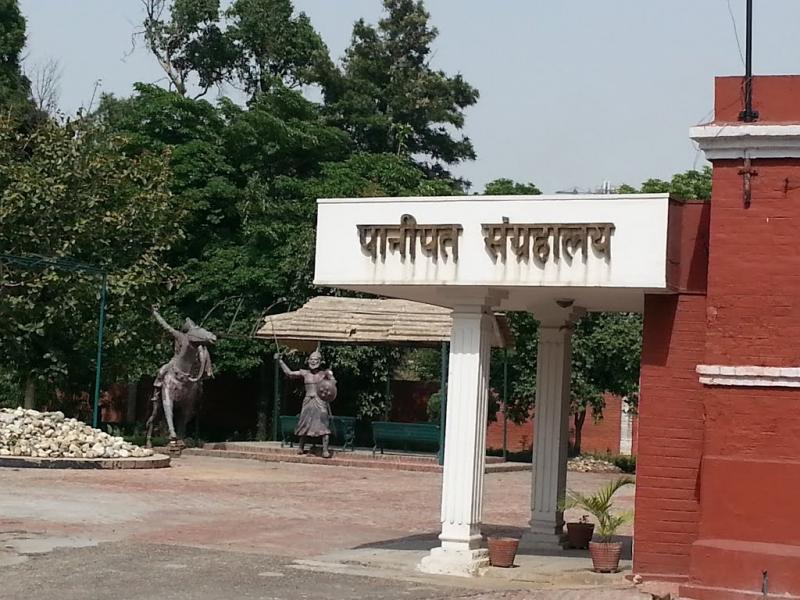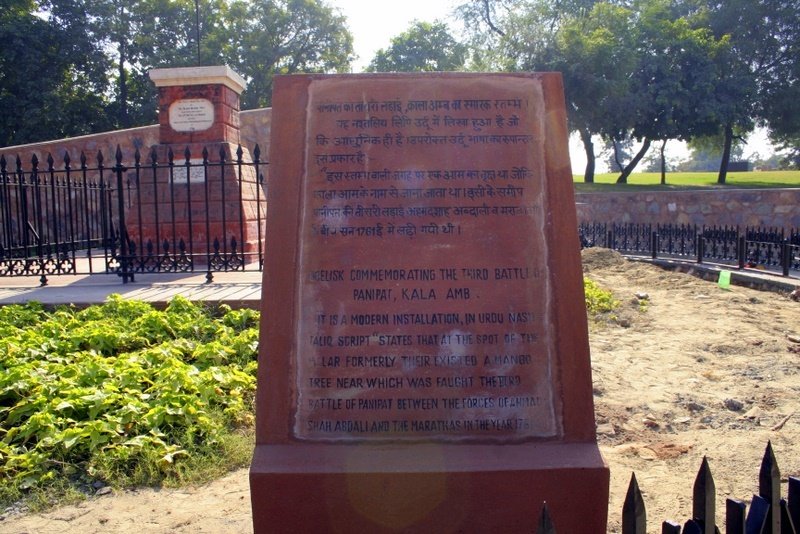Panipat
Panipat is a historic city in India’s Haryana state. It is located on NH-1, 95 kilometres north of Delhi and 169 kilometres south of Chandigarh. Three notable battles were fought around the city in 1526, 1556, and 1761. The city is renowned as the “City of Weavers” and “Textile City” in India.
OBELISK COMMEMORATED TO THE THIRD BATTLE OF PANIPAT
This obelisk was constructed under the British government in India by the then-Surveyor General of Archaeology. It commemorates the Third Battle of Panipat in 1761 AD. Sadashiva Rao Bhau, who led the Maratha resistance throughout the war, is said to have died here while fighting. The place is marked with a brick pillar with an iron rod at the top and an iron fence that surrounds the whole area. The Battles of Panipat Monument Society has built a spectacular war memorial complex around this monument on around 7 acres of land. The Haryana Government established this Society in 1981, under the presidency of Late Shri G.D. Tapse, the then Governor of Haryana, as a token of respect to the heroes and warriors who gave their lives in the three battles of Panipat. The Society has also established a Panipat Museum near the village of Binjhol on the Panipat-Gohana route, some 5 kilometres from Panipat. This museum displays documents, artefacts, and write-ups related to these wars, as well as archaeological and ethnological items.
How to Reach Panipat:
By Air:
Panipat does not have any air connections. The nearest airport is IGI Airport in New Delhi, which is 106.1 kilometres distant from Panipat via NH 44.
Nearest Airport: Indira Gandhi International Airport (DEL) – 94 kms from Panipat
By Road
Regular bus services run to and from Panipat. They’re the most convenient method to travel, especially for budget travellers, because they run on a regular basis. You may also take a shared taxi/cab for the same purpose.
By Rail
The railway station at Panipat Junction connects the city to the rest of India. Rail services to and from Panipat are available on a regular basis. Apart from buses, this is another convenient mode of transportation.
Local transport
Panipat has several public transportation choices. You can get about in buses, vehicles, rickshaws, and cabs.
Best Places to Visit in Panipat
- Prem Mandir
Shri Prem Mandir is a Hindu temple. Ward 3 Panipat is where you’ll find Panipat. This is a centre of love and service to the poor. Shri Prem Mandir was founded in 1920 in LAYYAH (now in Pakistan) by the then-Founder, Shri Shri 1008 Shri Shantidevi Ji Maharaj, daughter of Shri Ghanshamdas ji Chandna. It was relocated to Panipat following Partition in 1947 and has since spread love and compassion throughout India. When the nation was partitioned in 1947, the first Guruji carried “Thakur Ji,” an idol of Lord Krishna, with her and perpetuated the rituals that had been established. The diaties were relocated to their current location in 1957. Shri Raghunath Prem Mandir, Insar Chowk, and Shri Shanti Prem Mandir, Patel Nagar are currently functioning on the same principles in Panipat. There are more branches in Bahadurgarh, Dujana, Gudiyani, Jhajjar, Sonipat, and Kanpur.
Shri Prem Mandir is centred on Panchsheel’s five fundamental ideologies: “Sewa, Simran, Satsang, Sanyam, and Sadgi” (service, remembering the god, attending prayers for God, self control and simplicity). This is completely in the jurisdiction of the ladies (Nari Shakti) and will stay so. The major goal here is to assist the destitute and oppressed people.
Before becoming BRAHMLEEN in 1980, Maharaj Shri Shri 1008 Shri Shanti Devi Ji developed a tradition for women. Following that, Shri Vasandi Bai Ji Maharaj, who was designated as the second guru, oversaw the temple’s operations for five years and became known as Avdhoot Sant. When she departed the earth and went to the sanctuary of God in December 2001, the task was passed on to Bal Brahmchari Shri Parkash Devi Ji Maharaj (the temple’s fourth Paramadyaksha). She also dedicated thirteen years of her life to the temple. However, she also left this planet for Nirvana in 2014. Following that, in July 2014, the role was passed on to Balbrahmchari Shri Kanta Devi Ji Maharaj, who became the Shri Prem Mandir’s Fifth “Paramadyhaksha.”
It is worth noting that Satsang, religious events, and God worship have been held regularly in the morning and evening according to Sanatan Dharam traditions from the day it was created. Every year in February, an annual celebration known as “PREM SAMMELAN” is held. Devotees from all over the country attend the ceremony to serve humanity and receive Gaddi’s blessings, as well as the blessings of the nation’s saints.
2. DEVI TEMPLE
The Devi temple is in Panipat, Haryana, India. Goddess Durga is honoured in the Devi temple. The temple is well-known in Panipat and draws a huge number of visitors. The temple is situated on the banks of a drought pond, which has been transformed into a park where children and old citizens may go for morning and evening walks. Ramlila has been held in the park every year during the Navratri festival for the past 100 years.
The temple contains all Hindu Gods and Goddess idols, as well as a Yaga Shala. The temple has been properly reconstructed with good construction, displaying a wonderful image of Indian architecture. Devotees from India go here to seek the Goddess’ blessings. The temple is said to have been erected in the 18th century, and its history dates back roughly 250 years.
During the 18th century, the Marathas ruled the region. Sadashivrao Bhau, a Maratha warrior, arrived here with his army to fight. Sadashivrao Bhau remained here for over two months for the fight against Ahmad Shah Abdali, who was a powerful invading force from Afghanistan.
Sadashivrao is said to have discovered the Goddess idol on the edge of the pond and subsequently chose to build a shrine. It is said that during the construction of the temple, the Goddess idol was moved from one location to another during the night, but the next morning, the Goddess idol was discovered at the original location. They therefore chose to construct the temple in the same location where the idol was discovered.
All Hindu festivals are observed at the Devi temple, and a special puja is held at the temple on the occasion of Durga Pooja and Navrati. During the Durga puja and Navrati festival, the temple is decked with lights and flowers. The spiritual environment of the temple provides worshipers with tranquilly of mind and heart
3. THE KALA AMB PARK
Kala Amb, a well-known location where the Third Battle of Panipat was fought, is located 8 kilometres from Panipat city. The name Kala Amb has an intriguing backstory. The Marathas arrived in North India with the intention of forever altering Indian politics. The Marathas, like Ibrahim Lodhi, were guilty of antagonising all possible friends and allies. A conflict occurred between Maratha soldiers and the Afghan army. The Maratha force was surrounded by Afghan opponents, and its supply and reinforcement lines were cut off. Marathas suffered a total of 75,000 fatalities, including key commanders and Peshwa’s son. The battlefield was littered with dead bodies. This location is now preserved by the Kala Amb Park on the outskirts of Panipat. People gather here in droves to take a stroll in the tranquil surroundings.
A crimson obelisk stands at one of the park’s corners. This is the location where Maratha general Sadashiv Rao Bhau was killed during the conflict. According to legend and local legend, a black mango tree existed at this location, and it was under this tree that Bhau fought his final battle. The black mango tree no longer exists, but it has left its mark on the park, hence the name: Kala Amb.
4. KABULI BAGH MOSQUE, PANIPAT
Samrat is an abbreviation for Samrat Hem Chandra Vikramaditya, often known as Hemu, became Emperor of India after defeating Mughal Emperor Akbar in the Battle of Delhi in 1556. Between 1553 and 1556, Hem Chandra won 22 engagements against Mughals and Afghan insurgents before taking Delhi. Hem Chandra, from Rewari in Haryana, was a Suri dynasty adviser who originally procured critical supplies such as cannons and gun powder for Sher Shah Suri in the 1530s, and held several posts under Sher Shah’s son Islam Shah and Adil Shah’s regimes. Hem Chandra became Adil Shah Suri’s Prime Minister and Chief of Army in 1553, and fought 22 wars from Bengal to Punjab, conquering all of them without a single loss. On October 7, 1556, he had his official Coronation or ‘Rajyabhishake’ at Purana Quila in Delhi. After 350 years of foreign domination, a Hindu was able to become king of Delhi. Hem Chandra was India’s last Hindu Emperor. However, Hem Chandra was killed at the Second Battle of Panipat on November 5, 1556, when an arrow struck his eye, causing him to lose consciousness and die quickly. His body was kidnapped and carried to Akbar’s army camp at Saudapur hamlet, which is now the current location. Bairam Khan encouraged Akbar to behead Hem Chandra’s dead body in order to obtain the title of Ghazi. Following that, Hemu’s head was sent to Kabul for display at the Delhi Darwaza at Kabul Fort to show Afghans that the great warrior was dead, and his torso was hanged on a gibbet outside Purana Quila in Delhi, where Hem Chandra was coronated as the Vikramaditya king after his victory, to instil fear among the locals. At the site of the beheading, Hem Chandra’s followers erected a ‘Chattri,’ also known as a traveller’s shelter. The Haryana government intends to build a monument on the current site.
5. PANIPAT MUSEUM
The primary goal of building Panipat Museum was to disseminate knowledge and raise awareness about Haryana’s archaeology, history, art, and crafts. Antiquities, inscriptions, sculptures, guns and armours, ceramics, antique and precious papers, jewellery, art and craft products, and so on are all on show at the museum. It also gives a unique opportunity to see the valour of gallant and patriotic fighters who gave their life during the Battle of Panipat through various write-ups, pictures, and trans-slides.
One of the museum’s main draws are enlarged photos of significant miniatures. These miniatures are from Baburnama and Akbarnama, respectively. These were collected from prestigious institutions such as the National Museum of New Delhi, the British Library, and the Victoria and Albert Museum in London. Importantly, the majority of the traditional artefacts and other objects are sourced from Haryana’s many districts.

6. SALAR GUNJ GATE
Salar Gunj Gate, as the name implies, was created in commemoration of Salar Jung, the Nizam of Hyderabad’s prime minister. Salar Jung, the Nizam of Hyderabad’s prime minister, naturally followed in the footsteps of the Nizam of Hyderabad, who was a puppet of the British administration in India.
He publicly supported the British administration during the First War of Indian Independence. He learned of the intention of Indian independence fighters to attack the residence in Hyderabad and alerted his superiors in plenty of time so that they could beat them. He was knighted and granted the title Salar Jung in addition to his knighthood. While he was technically known as Sir Salar Jung, the general public referred to him as Nawab Sahib. Faiz Nawab Sadak, one of Salar Gunj’s fans and companions, created the Salar Gunj Gate in his honour. It is situated in the heart of Panipat, over the main arterial route.
7. Tomb Of Bu-Ali Shah Kalandar
This mausoleum, dedicated to Shaikh Sharafudeen Bu Ali Qalandar Panipati, a saint of the Chisti order who lived in India, is a popular tourist destination. The tomb, which is about 700 years old, is a symbol of faith, peace, and honesty. There are two other tombs within the enclosure: that of Hakim Mukaram Khan and the prominent Urdu poet of the period, Maulana Altaf Hussain Ali. Every Thursday, people of all races, creeds, and religions gather here to pray. The annual Urs Mela (festival) hosted at the tomb attracts worshippers from all across the country, and the venue comes alive with festivities. Regular qawwali festivals are also conducted near the tomb, and tourists go to see the dazzling performances by traditional singers. A visit to the mausoleum, which is located near Ibrahim Lodhi’s burial, is a really tranquil experience.
8. BAB-I-FAIZ GATE
Salarganj Gate is another name for Bab-i-Faiz Gate. The gate is made of brickwork and has a stone base. The entrance is made up of two arched entrances on either side of the corridor. It once functioned as the entryway to the town of Panipat. The outer multi-fold arch’s sides are embellished with panels and arched niches, while the interior arches are clad in red sandstone. An inscription in Urdu written atop the pointed arch of the entrance reads Bab-i-Faiz Nawab Sadiq-1129, hence the gateway is known as Bab-i-Faiz gate, which means ‘door of beneficence.’ Nawab Sadiq constructed it in 1737 AD.
9. IBRAHIM LODHI’S TOMB
Ibrahim Khan Lodhi’s grave is located in a park managed by the Panipat Municipal Corporation. The mausoleum is next to the tehsil office and the dargah of Sufi saint Bu Ali Shah. On April 21, 1526, he was defeated and died in the First Battle of Panipat while fighting against Mughal ruler Babur. All that remains is a rectangular open tomb on a high double-terraced platform reached by a flight of stairs on two sides made of Lakhauri bricks. This is the ultimate resting site of Delhi’s last Sultan, Ibrahim Lodi. An inscription in a niche beside the burial indicates that the District Administration restored this monument during the British government in 1867 AD. It has little architectural importance, but it has unparalleled historical relevance.
Stay visited chaloghumane.com to know the offbeat travel places in domestic and international destinations.

